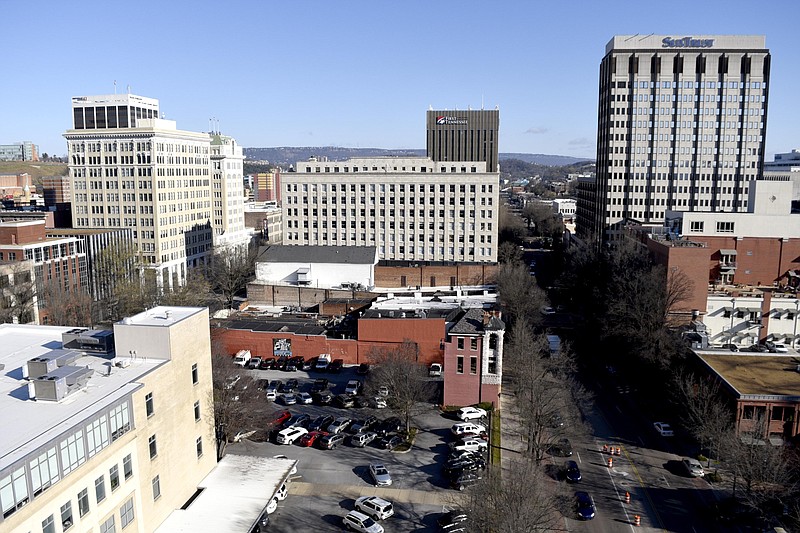Not long after his recent report on collapsing racial dynamics in downtown Chattanooga was made public, Dr. Ken Chilton stood before a crowded sanctuary at Alton Park's Westside Baptist Church.
It was evening, two Fridays ago. Blacks, whites, young, old, preachers, activists, retirees, reporters - they all came to hear Chilton's report on why downtown Chattanooga has become, as some say, segregated.
Chilton, an associate professor at Tennessee State University, began with a question.
"How many people in the audience are from the mayor's office?" he asked. "Or the county? Or River City? Or the Enterprise Center?"
He wasn't being snide. When the most powerful people in the city - nearly always white and wealthy - are not close to the stories, sights, heartaches and desires of those near the bottom of the power structure - nearly always of color and poor - then our city becomes damaged and divided.
That's why Chilton asked.
"Those are the people that need to be here," he said. "Not to listen to me, but to talk to people."
For the next 90 minutes, Chilton and the audience discussed his report. (So who was there exactly? Take a guess.)
In last 17 years, there's been an exodus of black Chattanoogans. Downtown has become a mostly white experience, defined not by separate bathrooms, but manipulated economic forces, cultural affinities and branding, and elite-driven, PILOT-ed policies.
Between 2000 and 2017, more than 2,500 black Chattanoogans moved out of downtown.
And more than 5,000 white Chattanoogans moved in.
Chilton's report, released by Chattanooga Organized for Action, called it our new form of "Negro Removal," echoing back to destructive government-led policies from the 1950s.
* In 2000, the median income for white households in Chattanooga was $37,200.
In 2017, it had jumped to $52,600.
In 2000, the median income for black households in Chattanooga? $23,000.
In 2017, it was less than $28,000.
* In Chattanooga, 53 percent of black Chattanoogans earn less than $30,000.
More than 20 percent of white Chattanoogans earn $100,000 or more.
Less than 6 percent of black Chattanoogans do.
"I'm stuck and I'm sick and tired," one woman, an elderly African-American, told Chilton that night. "It's the same people. The old man 20 years ago and junior now. It's the same money. It's the same money."
The renaissance money has not trickled down. Our schools are not remarkably funded. Our poor communities not resurgent.
Chilton was hesitant to say this was deliberate.
Others were not.
"We either unite or die," proclaimed one woman, a younger African-American. "We are not in the planning sessions and I will say it is deliberate. When you look out and see we are not there, you know it's happening."
Why has city leadership not paused with genuine deliberation to ask and examine the effects our branding and remaking have had on African-American communities?
When you look out and see we are not there, you know it's happening.
The shrinking downtown presence of African-Americans seems to be of partial concern to parts of the power structure, as if black citizens are an afterthought in downtown planning, a demographic able to be compromised in the pursuit of the bright lights of a big Gig City.
"There is a trail of tears that wraps throughout this city," another African-American woman said that night.
I'm not saying that white people who move downtown or enjoy downtown are racist. The point is larger than that.
The mechanisms that remade Chattanooga are the same mechanisms that influenced the flight of 2,500 black Chattanoogans. A wealthy, white planning process begets wealthy, white outcomes.
When you look out and see we are not there, you know it's happening.
This was not the original point of Chattanooga Venture, which led to the heralded "Chattanooga Way."
We need to return to that original intent.
Want solutions? There are a million.
But you won't get them in a column.
Find them in Alton Park. And East Chattanooga. And the Westside.
Find them in the folks who have never stepped inside a top-floor board room.
Find them in an entirely new way of city planning.
View other columns by David Cook
"Building process, building relationships, building citizens, trying to heal, trying to learn, trying to inspire, trying to uplift," one friend said.
When Chilton asked his Friday night question to the sanctuary crowd, no one from City Hall answered back. Or River City. Or The Enterprise Center.
But there was someone from the Community Foundation of Greater Chattanooga.
And the Benwood Foundation.
And, I'm told, the United Way.
That's a great, promising sign.
But it's not enough.
Our city leaders must wake up to this issue.
"It is time to fight," one African American woman said to the crowd. "The writing is on the wall."
David Cook writes a Sunday column and can be reached at dcook@timesfreepress.com or 423-757-6329.

